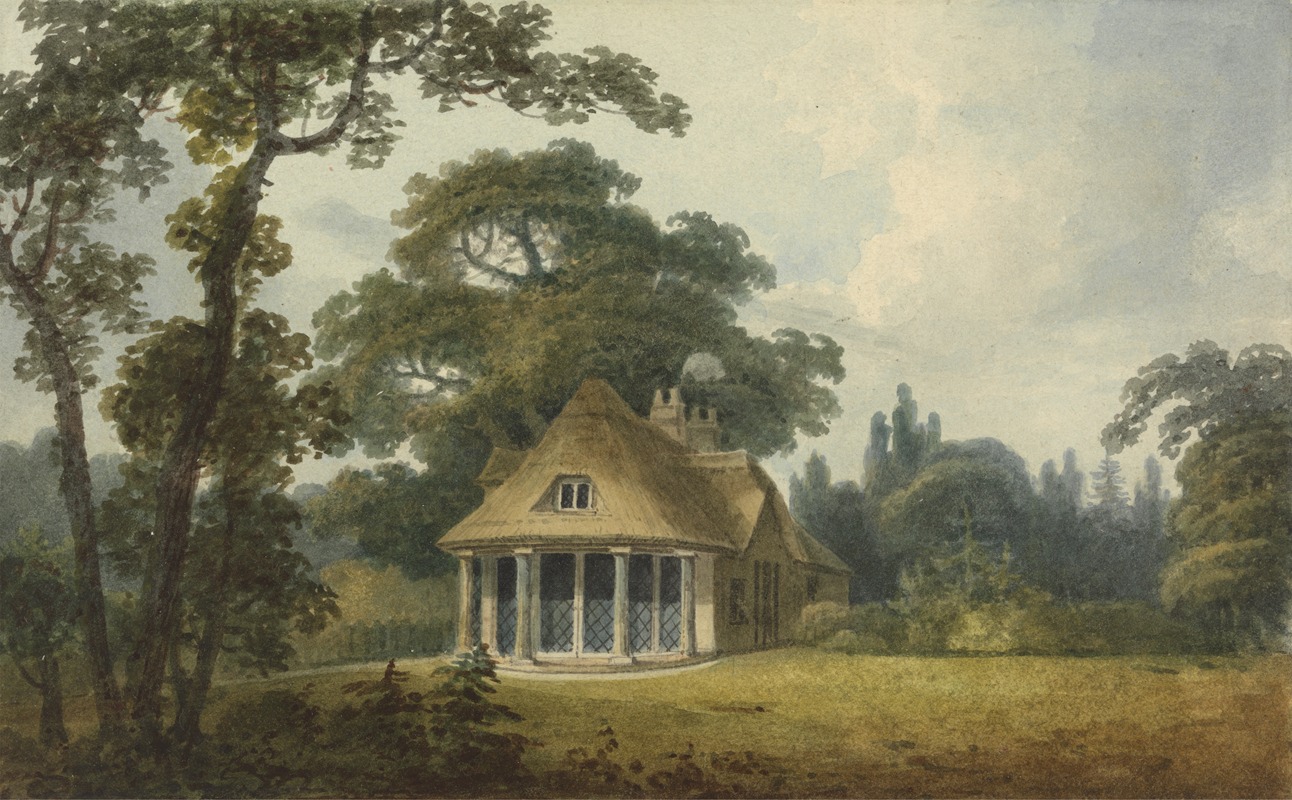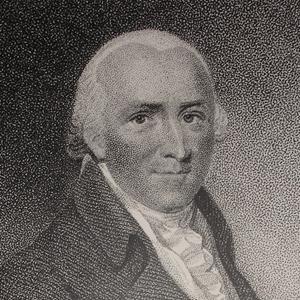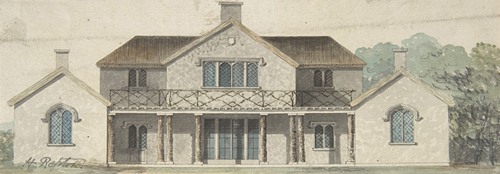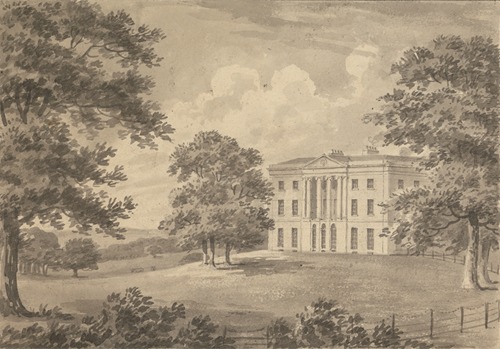

Humphry Repton was the last great designer of the classic phase of the English landscape garden, often regarded as the successor to Capability Brown. His style is thought of as the precursor of the more intricate and eclectic styles of the 19th century. His first name is often incorrectly spelt "Humphrey".
Unlike Brown and other famous predecessors, he only worked as a designer, not the contractor for executing his designs, and therefore made much less money. Many of his famous sketches with folding sections survive; these gave "before and after" views for his clients. He appears to be the first person to describe himself (on his business card) as a landscape gardener.
Repton was born in Bury St Edmunds, the son of a collector of excise, John Repton, and Martha (née Fitch). In 1762, his father set up a transport business in Norwich, where Humphry attended Norwich Grammar School. At age twelve, he was sent to the Netherlands to learn Dutch and prepare for a career as a merchant. However, Repton was befriended by a wealthy Dutch family and the trip may have done more to stimulate his interest in 'polite' pursuits such as sketching and gardening.
Returning to Norwich, Repton was apprenticed to a textile merchant, then, after marriage to Mary Clarke in 1773, set up in the business himself. He was not successful, and when his parents died in 1778 used his modest legacy to move to a small country estate at Sustead, near Cromer in Norfolk. Repton tried his hand as a journalist, dramatist, artist, political agent, and as confidential secretary to his neighbour William Windham of Felbrigg Hall during Windham's very brief stint as Secretary to the Lord Lieutenant of Ireland. Repton also joined John Palmer in a venture to reform the mail-coach system, but while the scheme ultimately made Palmer's fortune, Repton again lost money.
Repton's childhood friend was the botanist James Edward Smith, who encouraged him to study botany and gardening; Smith reproduces a long letter from Repton in his Letter and Correspondence. He was given access to the library of Windham to read its works on botany.
His capital dwindling, Repton moved to a modest cottage at Hare Street near Romford in Essex. In 1788, aged 36 and with four children and no secure income, he hit on the idea of combining his sketching skills with his limited experience of laying out grounds at Sustead to become a 'landscape gardener' (a term he himself coined). Since the death of Capability Brown in 1783, no one figure dominated English garden design; Repton was ambitious to fill this gap and sent circulars round his contacts in the upper classes advertising his services. He was at first an avid defender of Brown's views, contrasted with those of Richard Payne Knight and Uvedale Price, but later adopted a moderate position. His first paid commission was Catton Park, to the north of Norwich, in 1788.
That Repton, with no real experience of practical horticulture, became an overnight success, is a tribute to his undeniable talent, but also to the unique way he presented his work. To help clients visualise his designs, Repton produced 'Red Books' (so called for their binding) with explanatory text and watercolours with a system of overlays to show 'before' and 'after' views. In this he differed from Capability Brown, who worked almost exclusively with plans and rarely illustrated or wrote about his work. Repton's overlays were soon copied by the Philadelphian Bernard M'Mahon in his 1806 American Gardener's Calendar.
To understand what was unique about Repton it is useful to examine how he differed from Brown in more detail. Brown worked for many of the wealthiest aristocrats in Britain, carving huge landscape parks out of old formal gardens and agricultural land. While Repton worked for equally important clients, such as the Dukes of Bedford and Portland, he was usually fine-tuning earlier work, often that of Brown himself. Where Repton got the chance to lay out grounds from scratch it was generally on a much more modest scale. On these smaller estates, where Brown would have surrounded the park with a continuous perimeter belt, Repton cut vistas through to 'borrowed' items such as church towers, making them seem part of the designed landscape (coincidentally a concept common in East Asian gardening). He contrived approach drives and lodges to enhance impressions of size and importance, and even introduced monogrammed milestones on the roads around some estates, for which he was satirised by Thomas Love Peacock as 'Marmaduke Milestone, esquire, a Picturesque Landscape Gardener' in Headlong Hall.
Around 1787, Richard Page (1748–1803), landowner of Sudbury, to the west of Wembley decided to convert the Page family home 'Wellers' into a country seat and turn the fields around it into a private estate. In 1792 Page employed Humphry Repton, by then famous as a landscape architect, to convert the previous farmland into wooded parkland and to make improvements to the house. Repton often called the areas he landscaped 'parks', and so it is to Repton that Wembley Park owes its name. The original site that Repton so transformed was later built on in the construction of the short-lived Watkin's Tower, intended to be taller than the Eiffel Tower in Paris. The area landscaped by Repton was larger than the current Wembley Park. It included the southern slopes of Barn Hill to the north, where Repton planted trees and started building a 'prospect house' – a Gothic tower offering a view over the parkland. Repton may also have designed the thatched lodge that survives on Wembley Hill Road, to the west of Wembley Park. It is in the cottage orné style frequently used by Repton. Regrettably, Repton's Red Book for Wembley Park, which would give a definitive answer, has not survived.
Capability Brown was a large-scale contractor, who not only designed, but also arranged the realisation of his work. By contrast, Repton acted as a consultant, charging for his Red Books and sometimes staking out the ground, but leaving his client to arrange the actual execution. Thus many of Repton's 400 or so designs remained wholly or partially unexecuted and, while Brown became very wealthy, Repton's income was never more than comfortable.
Early in his career, Repton defended Brown's reputation during the 'picturesque controversy'. In 1794 Richard Payne Knight and Uvedale Price simultaneously published vicious attacks on the 'meagre genius of the bare and bald', criticising his smooth, serpentine curves as bland and unnatural and championing rugged and intricate designs, composed according to 'picturesque' principles of landscape painting. Repton's defence of Brown rested partly on the impracticality of many picturesque ideas; as a professional, Repton had to produce practical and useful designs for his clients.
Paradoxically, however, as his career progressed Repton drew more and more on picturesque ideas. One major criticism of Brown's landscapes was the lack of a formal setting for the house, with rolling lawns sweeping right up to the front door. Repton re-introduced formal terraces, balustrades, trellis work and flower gardens around the house in a way that became common practice in the nineteenth century. He also designed one of the most famous 'picturesque' landscapes in Britain at Blaise Castle, near Bristol. At Woburn Abbey, Repton foreshadowed another nineteenth-century development, creating themed garden areas including a Chinese garden, American garden, arboretum and forcing garden. At Stoneleigh Abbey in 1808, Repton foreshadowed another nineteenth-century development, creating a perfect cricket pitch called 'home lawn' in front of the west wing, and a bowling green lawn between the gatehouse and the house.
Success at Woburn earned him a further commission from the Duke of Bedford. He designed the central gardens in Russell Square, the centrepiece of the Bloomsbury development. The gardens were restored with the additional help of archaeological investigation and archive photographs, to the original plans and are now listed as Grade II by Historic England. The square was to be a flagship commission for Repton and was only one of three within the central London.
Buildings played an important part in many of Repton's landscapes. In the 1790s he often worked with the relatively unknown architect John Nash, whose loose compositions suited Repton's style. Nash benefited greatly from the exposure, while Repton received a commission on building work. Around 1800, however, the two fell out, probably over Nash's refusal to credit the work of Repton's architect son John Adey Repton. Thereafter John Adey and Repton's younger son George Stanley Repton often worked with their father, although George continued to work in Nash's office as well. It must have been particularly painful for Repton when Nash secured the prestigious work to remodel the Royal Pavilion at Brighton for the Prince Regent, for which Repton himself submitted innovative proposals in an Indian style.
On 29 November 1811 Repton suffered a serious carriage accident which often left him needing to use a wheelchair for mobility. He died at age 65 in 1818 and is buried in the graveyard of the Church of St Michael, Aylsham, Norfolk.
Three roads close to the vicinity of his cottage at Hare Street (now renamed Main Road) in the Gidea Park area of Romford were named after him; Repton Avenue, Repton Gardens and Repton Drive, respectively. A plaque was unveiled on the former site of his cottage on 19 April 1969. The cottage was long since demolished and a branch of Lloyds TSB is situated on the junction of Hare Street and Balgores Lane.
In addition to his innovations in landscape architecture, Repton's 1803 quote "the thorn is the mother of the oak" has become a tenet of rewilding, where thorny plants are used to protect young native saplings from overbrowsing by rabbits and deer.


